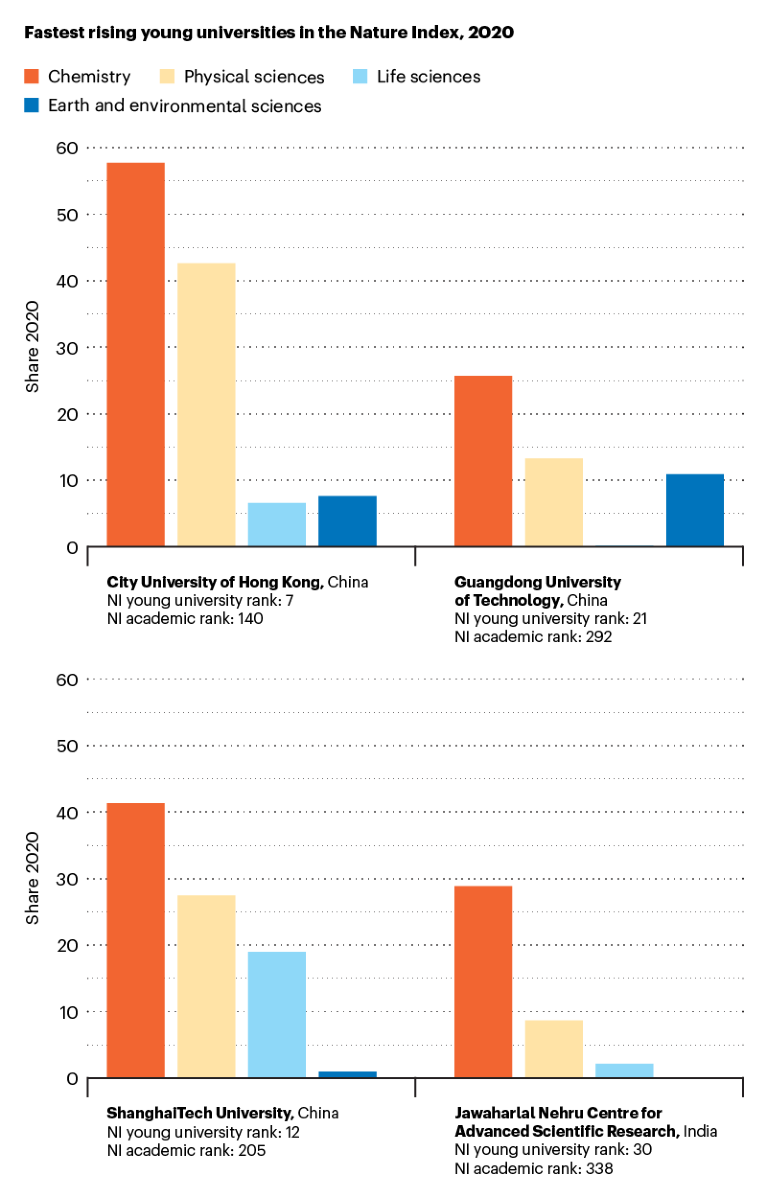Success factors
Among the leading 75 young universities in the Nature Index, one of the youngest, the Southern University of Science and Technology (SUSTech) in China, had the second-highest output in the 82 selected journals tracked by the index in 2020, graphed here by our key metric, Share. At 221.61, SUSTech's Share was slightly ahead of Singapore's Nanyang Technological University, with a Share of 221.41. The University of Chinese Academy of Sciences, the leading young university in the index, had almost double the Share of SUSTech (425.66) in 2020. For contrast, the leading institution in the Nature Index, the Chinese Academy of Sciences, had a 2020 Share of 1,886.71.

Source: Nature Index. Data analysis: Bo Wu; infographic: Bec Crew and Tanner Maxwell
Collective attributes
As a group, young universities cluster in the lower ranks of the Nature Index. They are relatively evenly spread across the age bands under 50, except the youngest. The Asia-Pacific region, specifically China, has the greatest number of young universities.

Source: Nature Index. Data analysis: Bo Wu; infographic: Bec Crew and Tanner Maxwell
Leading four
Among the leading 150 young universities in the Nature Index, these four had the highest Share in 2020. The leading young university, the 43-year-old University of Chinese Academy of Sciences (UCAS), now rivals China’s top universities. UCAS placed between Peking University and Nanjing University, both more than twice its age, in the Nature Index’s overall ranking of academic institutions for 2020.

Source: Nature Index. Data analysis: Bo Wu; infographic: Bec Crew and Tanner Maxwell
Rising stars
SUSTech and the Korea Advanced Institute of Science and Technology (KAIST), shown in the graphs above, were the two fastest rising young universities in the Nature Index, with a change in adjusted Share for 2019–20 of 88.77 and 31.81, respectively. The following four rising stars, shown here, achieved changes in adjusted Share of 23.70 (City University of Hong Kong); 19.82 (Guangdong University of Technology); 15.44 (ShanghaiTech University); and 15.37 (Jawaharlal Nehru Centre for Advanced Scientific Research).

Source: Nature Index. Data analysis: Bo Wu; infographic: Bec Crew and Tanner Maxwell
The specialists
Among the 10 leading young universities for each subject area in 2015–20, these institutions had the highest proportion of their total Share attributed to that subject. For the China Pharmaceutical University, for example, 79.6% of its total Share for the period is attributed to chemistry, the subject for which it is ranked 10th among young universities in the Nature Index. The University of Texas Health Science Center at Houston got 96.5% of its Share from life sciences, and ranked 3rd among young universities in the subject.

Source: Nature Index. Data analysis: Bo Wu; infographic: Bec Crew and Tanner Maxwell

 Universities under 50 chart a clear roadmap for the future
Universities under 50 chart a clear roadmap for the future
 Young universities forge new paths to success
Young universities forge new paths to success
 Customized recruitment attracts top talent
Customized recruitment attracts top talent
 Industry demand drives innovation
Industry demand drives innovation
 Universities under 50 carve their niche
Universities under 50 carve their niche







